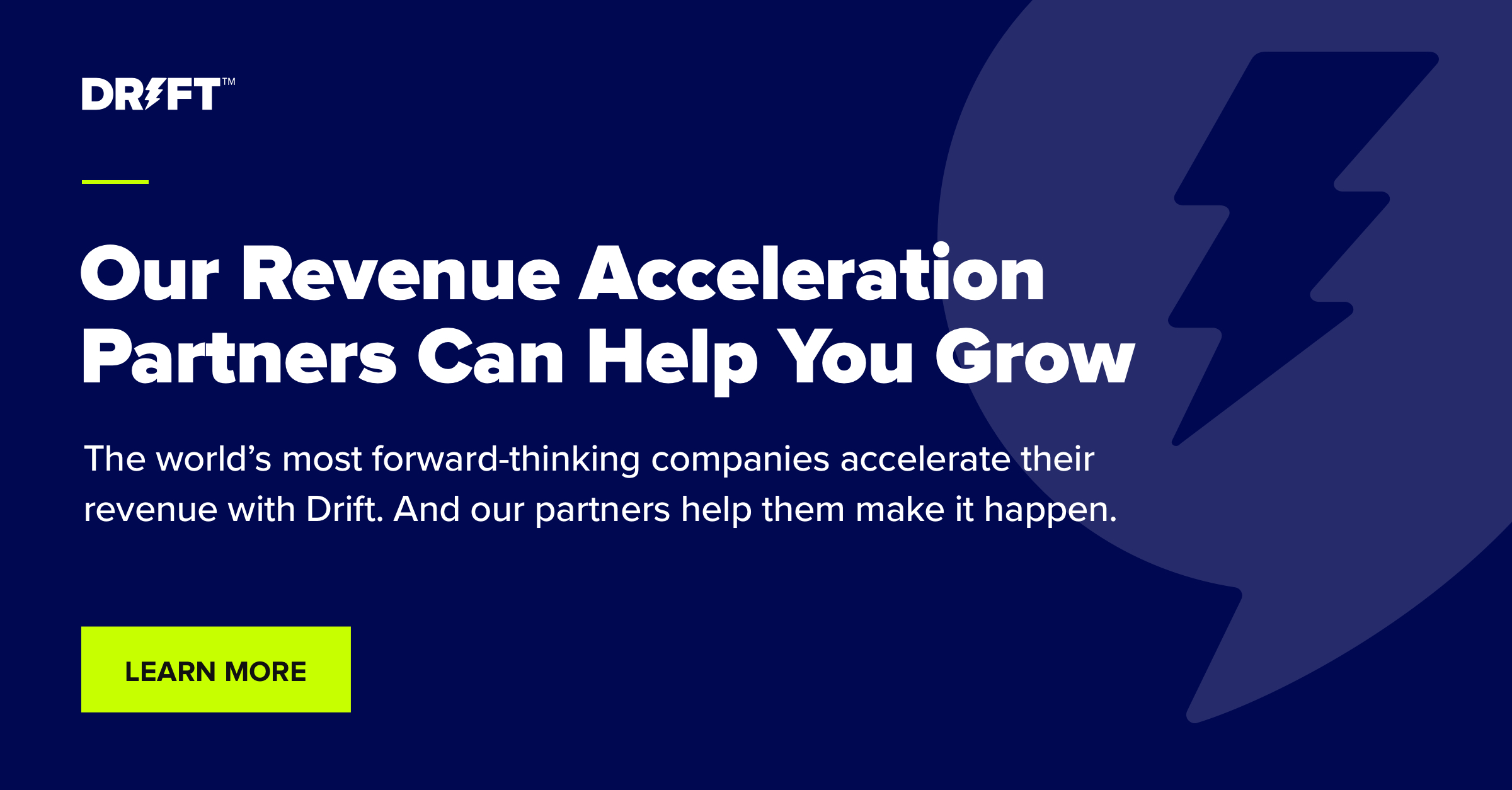Companies have relied on big in-person events for decades to build excitement around their products or services, start conversations, generate leads, and most importantly, forge relationships.
And then suddenly, all of that ground to a halt.
For the second year in a row, many organizations canceled their live gatherings in 2021 due to concerns about spreading COVID-19. Virtual events took their place.
While it’s likely that many events will eventually resume offering in-person options, a LinkedIn report declares that virtual events are “here to stay.” These were the stats that jumped out at me:
- 75% of event marketers worldwide say they plan to continue hosting virtual events.
- 40% say they will host more virtual events than in-person ones.
- Only 34% say they will host more in-person events.
Virtual events have some advantages over live ones. They’re accessible to worldwide audiences and a wider range of speakers, people can often view or review presentations on their own time, and digital event platforms produce data that helps event marketers track engagement.
But many virtual events struggle to replicate the interpersonal magic that makes events so valuable in the first place.
When all your attendees are sitting alone in front of their own screens, how can you create the meaningful interactions events are known for?
Using Conversational Marketing to Engage Virtual Event Attendees
Iron Horse (one of the first agencies to qualify for Drift Solutions Partner Certification 😎) knew that Drift has doubled down on bringing the human touch back to virtual events.
Tasked by a client to “make sure all virtual event attendees felt comfortable with the virtual event platform and were able to get any questions answered quickly,” the Iron Horse team realized they could easily adapt their client’s Drift implementation to get the job done.
Thanks to its flexibility and ease of integration, Drift stood alongside Bizzabo, Iron Horse’s client’s virtual event platform, providing automated responses to common questions and directing tougher queries (or those with sales potential) to human representatives.
As a frequent participant in both in-person and virtual events myself, I was impressed by how comprehensively Iron Horse implemented Drift for this event. The team left no part of the experience out — from branding the bot, to creating playbooks for each touchpoint along the way, to helping the customer understand and commit to this strategy, and everything in between.
I wanted to find out if Iron Horse had any wisdom to offer other Drift users, many of whom — I’m sure — are planning events of their own.
So, I invited Ellen Smoley, Iron Horse’s Growth Marketing Manager, to answer a few questions for the latest entry in my ongoing series of Drift Solutions Partner spotlights.
Editor’s note: The following has been edited and condensed for clarity.
Nick Salvatoriello: Can you summarize the role Drift played in this virtual event?
Ellen Smoley: We used Drift as an acting help desk/virtual event kiosk to make sure all attendees knew how to best navigate the digital experience. This included:
- Helping attendees with technical difficulties
- Getting in touch with product experts on the spot
- Simultaneously tracking all conversations and attributions within our client’s marketing automation system, Marketo
Functionally, this means that when an attendee requested a demo, that person was immediately connected with a sales rep who asked additional qualification questions and then routed the attendees to the correct sales rep for follow-up within Salesforce.
Nick: How did you decide Drift was the right solution?
Ellen: We focused on our client’s need for robust integrations with the virtual event platform (Bizzabo) and ease of use.
Iron Horse’s deep experience and knowledge of Drift allowed our team to pull off complex playbooks, as well as implement multiple playbooks that were all active and working together to create a cohesive attendee experience and journey throughout the virtual event.
Since Drift is user-friendly, the team had no problem adapting the technology in our short timeline.
Nick: Can you walk us through the implementation process?
Ellen: We started by building out all the creative copy to match the brand voice. We even went as far as making our bot icon resemble the client’s actual product:
![]()
We then created branches in Excel to present to the client for approval:
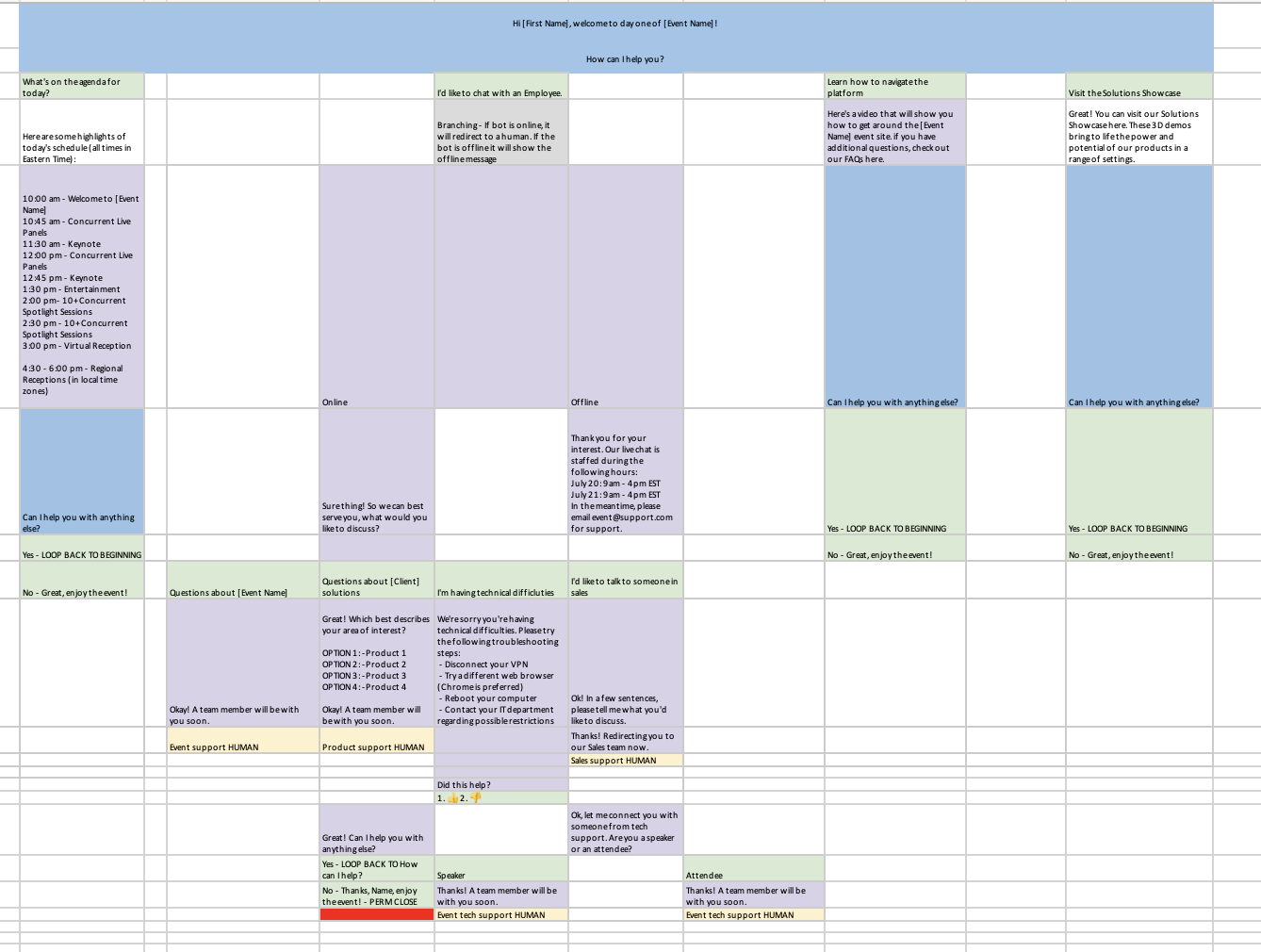
The “content blocks” used in multiple playbooks were approved on the first tab of the spreadsheet and then moved into the proper playbook and positioned accordingly once approved.
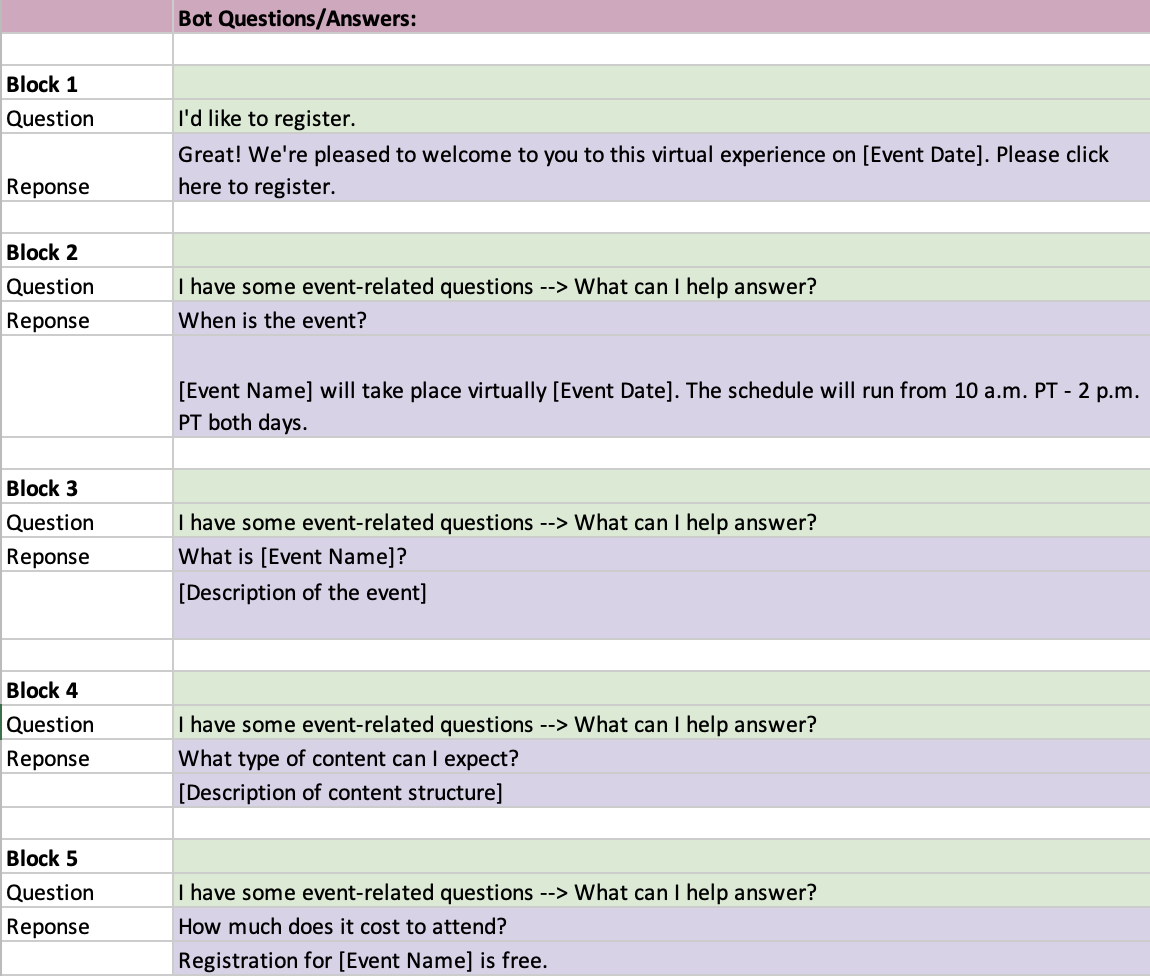
Nick: So that covers the technological aspect of the implementation. What about the human side of it?
Ellen: A large focus of our implementation was making sure we partnered with Drift to provide the best end-user experience and training.
We held in-depth meetings with our client’s marketing operations team to ensure all conversions were tracked within Marketo and Salesforce. This also allowed us to track attribution and pipeline contribution after the event.
When it came to training the bot staff, we ran through use cases and conducted drills to make sure everyone felt prepared and comfortable with the technology, were able to answer FAQs, and understood the bot’s “voice.”
Here’s a look at our agenda for those training sessions:
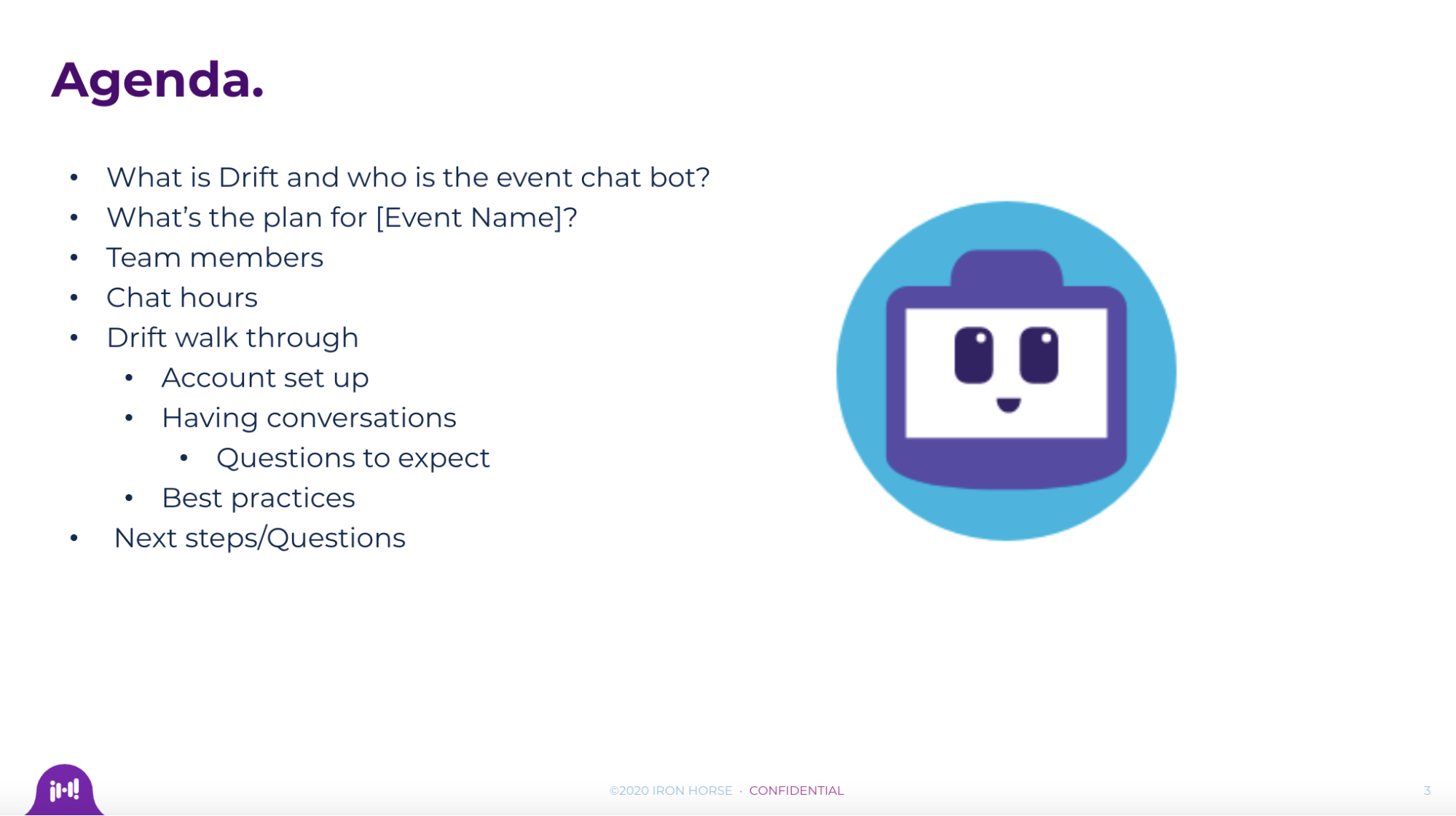
And here is a sample FAQ we created for the team:
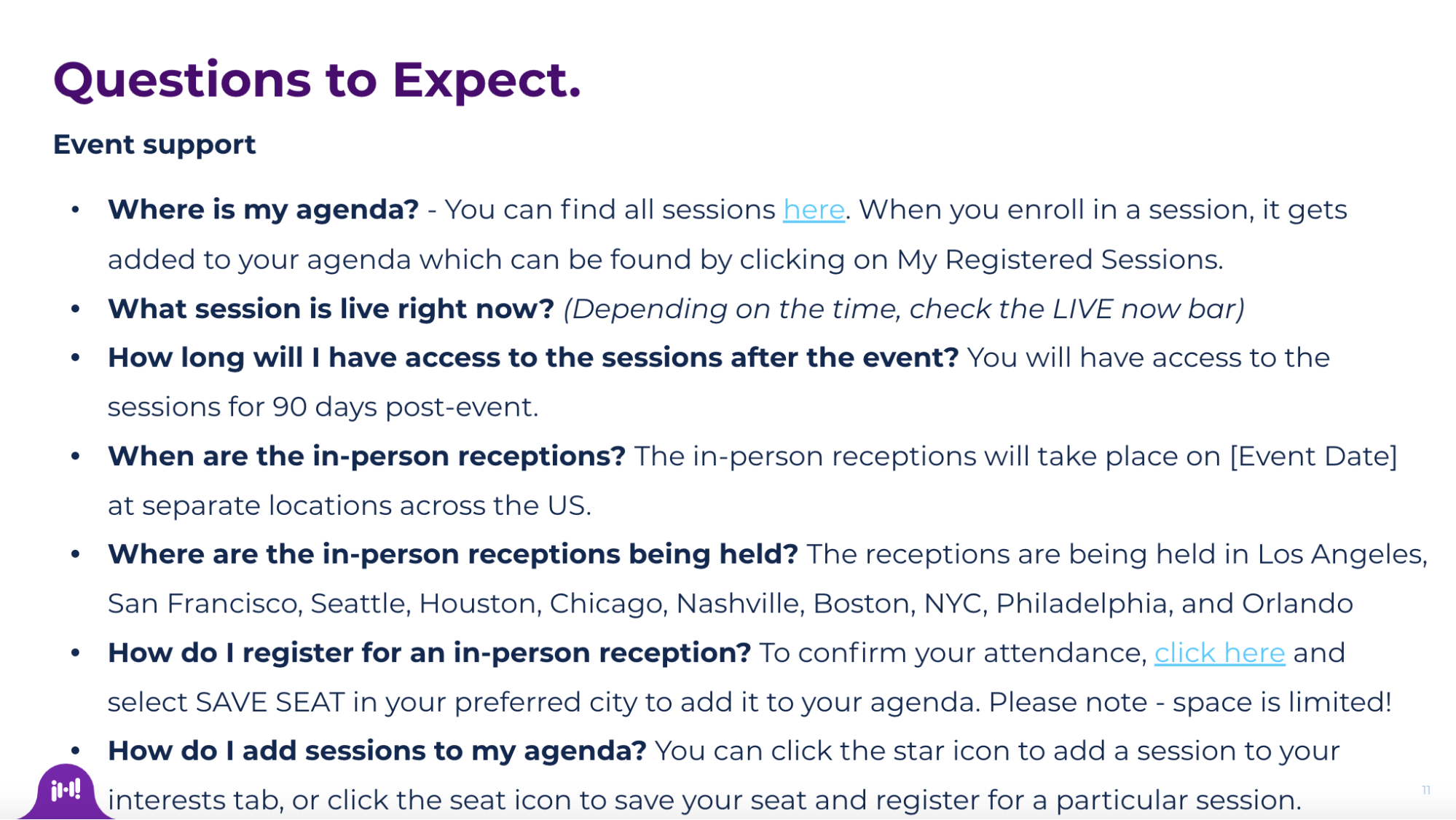
Drift’s ability to bring another member into a conversation gave an additional layer of comfort to our event Drift staff.
When attendees were directed to our event or technical support team members, and the support member was unsure of the answer, they could mention another key player in chat to help serve the attendee quickly and efficiently.
Nick: How did using Drift this way help your client run the event more smoothly?
Ellen: With the use of Drift, the event support team was not managing an email queue. Instead, they relied on team members and the bot responses, allowing them to focus on other aspects of virtual event management.
Furthermore, attendees were able to quickly and seamlessly request a demo and get in touch with a sales team member. By using this feature of Drift, we did not have to require additional support from the virtual event platform.
With the help of Drift, we received 182 conversations within two days. Of those conversations, 79% were handled by the bot itself!
Our client surveyed attendees post-event, and the event scored an impressive 98% satisfaction rate.
Without Drift, attendees would not have had a direct line to answers for all of their questions throughout the experience. This led to a frictionless process for the attendees to engage with the content, platform, and support staff.
Nick: Before we end our conversation, I want to congratulate you and the team at Iron Horse on earning Drift Solutions Partner Certification. Can you talk a little about how Drift fits in with your overall approach to helping clients at Iron Horse?
Ellen: Our data-driven approach focuses on creating integrated experiences across digital and human-to-human touchpoints. Iron Horse functions as an extension of our clients’ team through strategy, planning, execution, and management of marketing programs.
We work with our clients to optimize and integrate Drift so they can increase visitor-to-lead conversion, drive more qualified leads, and accelerate sales revenue to maximize their Drift investment, whether that’s through their website, partner programs, or virtual events.
Nick: Thanks for sharing your story today!
Ellen: It’s my pleasure to share what we’re doing and learning with fellow Drift customers. If readers have any questions, they can always visit our site and chat with us there.





